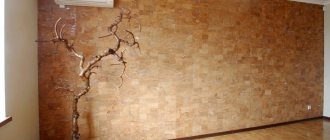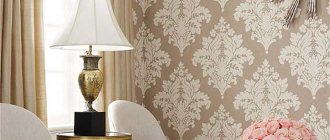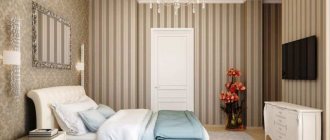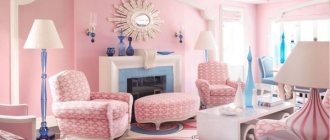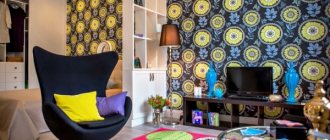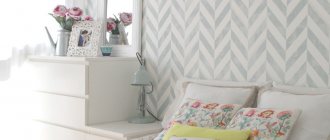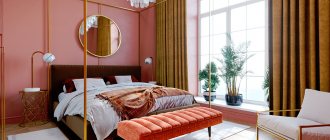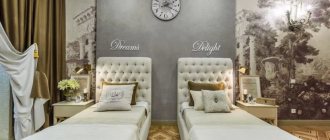Bedroom in a geometric style Living room: current trends in geometric format Geometry on the walls of the kitchen Hallway in a geometric style
Despite the constant replenishment of the assortment, it is the strict and restrained motifs that are the most popular, and the coverings that really cause delight are wallpapers with geometric shapes.
Geometric motifs on the walls allow you to set a certain rhythm and dynamism to the interior, can influence its size and the perception of the general environment, correct wall imperfections and transform the parameters of the room. The emphasis in this design will be on the simplicity of forms , as well as on the abundance of shades used.
We are ready to share with you the intricacies of using wallpaper with geometric patterns in the interior.
Types of geometric patterns on wallpaper
Geometric and abstract designs are classified from simple to complex - from spots or rhythmic motifs to complex ones that completely fill the plane.
Stripes - a classic wallpaper pattern
Stripes on wallpaper can outline or even change a space. Stripes in the interior are universal and can be monochromatic or multi-colored, narrow or wide, frequent or rare. They are very popular and perfectly complement interiors in classic styles.
Wallpaper with horizontal stripes
The influence of stripes on the geometry of the room:
- A vertically directed pattern can visually make the ceiling higher.
- The horizontal strip expands the surface on which it is glued.
- The diagonal direction is the most interesting - it can erase boundaries and corners, making long and elongated rooms more square.
Wallpaper with vertical stripes
Wallpaper with zigzag (herringbone)
The zigzag pattern is a bold solution for modern interiors. Zigzag perfectly blurs boundaries and smoothes out any irregularities or protrusions. The pattern itself is very dynamic and lively, so you shouldn’t overuse it.
Wallpaper with zigzag
The herringbone on the wallpaper can be either clearly defined, when the color of the pattern is contrasting with the color of the base, or more calm. Wallpaper with a contrasting pattern is best used to decorate one wall or part of it. If the zigzag is not very catchy, then all the walls can be covered with this wallpaper.
Diamonds and triangles on wallpaper
Wallpaper with rhombuses and triangles in different shades of the same color, made in muted, pastel colors, is suitable for classic interiors. These geometric patterns can add both lightness and energy to the interior.
If the rhombic contour on the wallpaper is formed by thin light lines on a muted background, then such a finishing material will be acceptable for finishing all the walls of the room.
Wallpaper with rhombuses in the interior
Diamonds of different sizes and different colors, as well as an excessively contrasting pattern, add dynamics. This wallpaper is best used to decorate an accent wall.
Checkered wallpaper
Tartan is a checkered design consisting of horizontal and vertical stripes, as well as rectangular areas filled with diagonal stripes. This pattern is very cozy and harmonizes perfectly with furniture made from natural wood.
Checkered wallpaper in the interior
A larger cage in other colors is often used to decorate rooms in a classic style.
Squares, rectangles on wallpaper
Squares or rectangles are a calmer pattern that is often used in Scandinavian interiors. It looks restrained, harmonious and does not overload the interior with excessive dynamics.
Squares on wallpaper in the interior
By choosing wallpaper with contrasting square colors, you can liven up a monochrome interior and give it character.
Rules for choosing a picture
When choosing a wallpaper design with a pattern, you should know some selection rules.
- For low rooms it is better to choose a vertically located pattern or ornament. This will help visually raise the ceiling.
- A pattern or strip with a horizontal arrangement will make the room lower, but much more spacious.
- For small rooms, wallpaper in lighter colors with small patterns is suitable.
- A combination option will allow you to make the room deeper.
- In general, when choosing a patterned wallpaper design, you should also take into account the size of the room, the degree of illumination and how much sun gets into the room.
- When purchasing wallpaper with an ornament, you should remember the presence of rapport.
Decorating the rooms
The purpose of the room plays a significant role when choosing finishes for walls with geometry.
Wallpaper with precise mathematical figures is very popular for the design of walk-through spaces such as the hallway and corridor. In such interiors, the pulling effects of finishing will not interfere, because the rooms are not large in size. For hallways that are deprived of natural light, geometric patterns on a light background will be relevant. They will make the room brighter and more interesting.
When decorating the kitchen, the most popular place in the apartment where the whole family likes to gather, the wall decoration should emphasize the cozy home environment. Materials in the spirit of Provence or made in country style will be successful. For example, a blue and white checkered pattern on the walls will convey the cleanliness and freshness of the room. And the fashionable patchwork wallpaper style will make the room bright and unusual.
Modern trends allow for strict geometric patterns in the kitchen space. These can be elements of complex computer graphics or the usual spectacular rhombuses.
When decorating a living room, geometric shapes and lines are considered the best option, because geometry is a very powerful tool that allows you to set the desired rhythm to the room. The pattern of the material can be either a small abstract drawing or a modern 3D picture.
Boudoir requires creating a calm, peaceful atmosphere in which you can relax and lose yourself. The surface of the walls should be unobtrusive and pleasing to the eye.
Prints imitating light floral motifs will help create a cozy atmosphere. It is better to give preference to light neutral spectrums: pastel green and blue, beige, light yellow, gray.
The children's room requires special attention. If you consider that a child’s bedroom is used for different purposes, then it is more logical to zone the interior using wallpaper. For example, for a relaxation and sleeping area, choose a discreet ornament in muted tones: small polka dots in pastel colors, businesslike diamonds, squares or rectangles in the beige-gray spectrum.
Geometry and lighting
Lamps in a geometric style cannot be confused with other representatives of lighting design. They are distinguished by rigor and conciseness, as well as simplicity of lines and shapes. The variety of options presented is amazing. Geometric lampshades can be made of metal, plastic, wood, glass, paper. They are presented in the form of open “crystals” made of metal rods or closed structures. For the first, it is necessary to provide lighting devices that do not have a negative effect on vision. LED elements will cope best with this task. The variety of multifaceted designs is amazing. Chandeliers, floor lamps, spots are given the shape of a cube, cylinder, prism, tetrahedron, sphere, cone, pyramid. Such decorative elements provide truly unlimited design possibilities. Incredibly attractive lampshades with openwork edges. The light coming through the holes draws graceful lace patterns on the walls and ceiling. They fill the room with mystery and magic.
Advantages
Properly selected wall coverings with geometric patterns are an indicator of the impeccable taste of the home owners. Such wallpapers have many advantages:
- set the rhythm of the entire space: they are able to bring both dynamism and rhythm to the interior, and give it calm restraint and a peaceful atmosphere;
- allow you to achieve amazing visual effects - by stretching the walls up or visually expanding the room;
- capable of masking surface imperfections;
- the variability of geometric patterns allows you to use such wallpaper in different interior styles;
- The abundance of shades and textures of the coating gives the consumer plenty of choice.
Advantages and disadvantages
Like any other finishing material, wallpaper with a geometric pattern has its advantages and disadvantages.
And now we will not talk about the wallpaper itself, but about the print.
The benefits include:
- The ability to radically change the “mood” of the room. A pattern can both add dynamics and rhythm, and balance the interior and make it calm and peaceful;
- The ability to hide imperfections in the geometry of the room with the help of a well-chosen pattern - elongate the walls, widen them or bring them closer to each other;
- Any pattern on the wall hides its minor imperfections, protrusions or irregularities;
- A wide range makes it possible to choose the ideal ornament for each individual room;
- The geometric pattern fits perfectly into any interior style.
As for the disadvantages:
- Like any wallpaper with a pattern, a geometric pattern has a report - a selection. When it comes to decorating an entire room, there can be quite a lot of leftovers;
- A geometric print requires very precise joining of the canvases to each other and strict adherence to verticality. Otherwise, all the inconsistencies will immediately catch your eye and spoil the design of the room;
- An ineptly chosen pattern can overload the room;
- Also, wallpaper with geometric patterns requires the correct selection of wallpaper companions, otherwise the print will look out of place, and the interior as a whole will not be complete.
Geometric wallpaper in the interior of different rooms
Let's consider the most successful ways to use such finishing in different rooms:
For a relaxation room, wallpapers on which the ornament is formed by thin, openwork stripes, or canvases with a very small print - checkered, diamonds, circles, are better suited;
In children's rooms, using such wallpaper it is easy to zone the space. The place for games can be more vibrant and dynamic. The relaxation area should be neutral, with a small pattern, so as not to irritate the child’s psyche and not cause involuntary concentration and overexertion. The pattern should be small and not frequent;
The article was written for the site remstroiblog.ru.
Expanding space with wallpaper
Geometric wallpaper patterns, when used wisely, can trick the eye into believing a room is larger than it actually is.
Also, a drawing can distract attention. For example, if you have a low doorway, then to de-emphasize it, place intricate wallpaper on the opposite wall.
A narrow room can be expanded using horizontal lines on the walls. Vertical stripes increase height. At the same time, the stripes do not have to be large and bright - pale and thin ones will give the same effect.
In spacious, well-lit rooms, you can use wallpaper with any pattern. It is also permissible to cover all walls with geometric wallpaper. But in this case, the drawing should not be large and not too contrasting.
How to cover the walls of a dacha inside inexpensively, maintain style and clean environment indoors
At the dacha you can relax not only from the city noise and bustle. Clean air is an integral part of outdoor recreation. Many are tormented by the question of how to cover the walls of a dacha inside inexpensively and maintain comfort. For this purpose, an environmentally friendly material is used that can easily withstand the winter unheated period. It is advisable to preserve the natural, country style of finishing.
Decorating the walls in the house with clapboard
Zoning using geometry
The superpowers of geometry are not limited to a set of tools for changing space. This is an ideal tool for competent zoning. Functional areas are highlighted using accent trim in the form of stripes, triangles, circles, honeycombs. The space is completely filled with geometric shapes or given the role of edging, and photo wallpapers or fractal posters are placed in the gap. In the living room, they decorate the space above the sofa, behind the TV, or highlight a short wall next to the dining group in a similar way. You can draw a boundary between zones using a line on the floor, using laminate or tiles in a contrasting color. A popular technique for designating zones is to place a rectangle of darker tiles under the dining group or in the center of the workspace inside a U-shaped set.
Design tips
To achieve harmony in the design of the room, you should listen to the following advice from experts:
- Wallpaper with a large pattern is best used in small quantities (on one of the walls), or in a large space with high ceilings.
- If the wall decoration will play the role of a background in the interior, it is more appropriate to choose plain materials of pastel colors with a light geometric texture or canvases with small floral prints.
- When you want to create an accent on the walls, you should give preference to large patterns and rich, “tasty” shades. A complex print is not the best choice in this situation; the room may be too crowded and uncomfortable to be in.
- The lighting of the room plays an important role: in a room with south-facing windows, it is better to choose materials that absorb excess light and cool colors. A cold room can be visually “warmed up” with warm shades of wallpaper.
Geometric wall coverings with large patterns always attract attention; against their background, curtains and other textiles should be plain and without additional ornament. The same rule applies to furniture: the larger and brighter the pattern, the calmer the surface of the furniture. Several varieties of ornament are considered bad form, even if the themes have something in common.
- Consider the purpose of the room. The decoration of the walls of residential premises should create a favorable emotional background for all household members. Psychologists insist that children choose the wallpaper for their bedroom themselves; they will definitely not point out what irritates them.
- The same applies to wall decoration in a marital boudoir - you definitely need to know the tastes of your other half.
For even more interesting information on how to choose wallpaper with a geometric print, watch the following video.
Wallpaper design in small rooms
When choosing a pattern for a limited space, pay special attention to proportions:
- Use small patterns in small rooms.
- Large drawing - for large rooms.
- It’s easy to destroy a small space with a huge bright pattern.
Up close the drawings look different. A small drawing (pattern) from a distance is perceived simply as a dominant color, thereby creating a sophisticated addition to the interior. Therefore, before using wallpaper with a certain design, you should always first look at the composition from afar.
When choosing wallpaper for a small room, you need to be guided by the rules of visual expansion of space. It is recommended to give preference to horizontal stripes of medium thickness with unclear contours. And in rooms where there is not enough natural light, you should not use cold shades.
Features of geometric wallpaper
Geometry wallpaper has won the loyalty of consumers for a reason: in rooms with different designs, shapes and layouts, they can create the most unusual effects.
Let's look at their capabilities:
- Wallpaper depicting straight lines or stripes is most often used to change the parameters of a room. Vertical lines allow you to raise the ceiling level, creating the effect of additional free space. The horizontal direction of such elements contributes to the visual expansion of the walls: this effect is especially relevant in narrow kitchens or corridors;
wall coverings with circles, squares, diamonds and other large geometric patterns create accents on the walls. That is why they are most often used in the design of residential premises, where it is necessary to highlight the main area. In addition to this effect, large figures contribute to the visual approximation of the walls and reduce the space;
Wallpaper with a small geometric pattern has the exact opposite effect: it makes the room wider and more spacious. Often, prints of these sizes are used to reflect country-style design features;
coverings with scenes in the form of bright circles help emphasize the dynamism of the interior. Polka dot wallpaper symbolizes cheerfulness and optimism, and large circles around the entire perimeter of the room help create a mysterious atmosphere and promote concentration;
squares and rectangles represent restraint and simplicity; they will not emphasize dynamism in the interior, but will help you concentrate, relax and unwind. Thanks to the orderliness of such motifs, the effect of a calm interior is created, which is not disturbed even when using bright accessories. Such motifs look best in modern designs;
Wallpaper in the form of waves and zigzags can provide effects similar to straight lines, but are most often used exclusively to create a bright and creative environment;
the cage is an excellent option for antique interiors and rooms in the English style. Thanks to the embodiment of checkered motifs in a variety of shades, you can emphasize the calmness, brightness, and unusualness of the design;
It is advisable to use diamonds in spacious rooms. The key role of such motifs in space is to create an energetic, cheerful and bright environment.
The use of wallpaper with geometry in the interior allows you to correctly play out any zone, which is why it is often typical for spacious rooms that perform several functions at once. For example, the combination of such coverings with another type of wallpaper allows you to divide the space of the kitchen and living room in studio apartments.
Remember! Since the geometric pattern on the walls must be consistent, carefully align the canvases before gluing the wallpaper to the surface around the entire perimeter of the room.
Despite the versatility and multifunctionality of such materials, gluing geometric wallpaper for walls requires compliance with several rules. First, try not to use a lot of bright accents in an interior decorated with wallpaper with a geometric pattern. Secondly, curtains and other textile design elements should be plain and have light or neutral shades. Thirdly, furniture in this design should be as simple as possible and not include bright inserts or cutouts.
Features and psychology of perception
The impression that geometry in interior design has on us is a signal about the degree of comfort of being in a given space. The introduction of geometric shapes can change the appearance of a room beyond recognition, improve or worsen its perception. Simple forms are perceived much easier than complex ones. In addition, they are better remembered. When perceiving a circle, square, rectangle, triangle, the distribution of attention occurs differently. Even in ancient times, it was noticed that geometric shapes affect the emotional sphere of a person. A square is associated with organization and competence, a circle represents goodwill, generosity, a triangle indicates leadership qualities, pragmatism, and determination.
Tips for application and color selection
When using wallpaper with a geometric print, it is very important to maintain the right balance and not overload the interior, both in color and decorative terms. Follow these tips:
Follow these tips:
Geometric wallpaper in a small room, first of all, should visually expand the space and not hide it. It is recommended to give preference to horizontal stripes of medium thickness with unclear contours. To prevent the design from rippling and being too contrasting, choose the following shades - light tones of yellow, blue, green, pink, sand. In small rooms where there is little natural light, you should not use cold shades. Small diamonds or zigzags can be used to decorate one wall. Then the rest should be plain;
- In spacious, well-lit rooms, you can use wallpaper with any pattern. It is also permissible to cover all walls with geometric wallpaper. But in this case, the drawing should be small and not too contrasting. Many people note that within large areas it is permissible to combine different types of geometric wallpaper - the main thing is that the design matches the theme. For example, large circles + small peas, etc. But it’s worth noting right away that without proper experience, it will be difficult to achieve a good result. Therefore, as an addition, it is better to choose plain canvases or plain wallpaper, but with a clearly defined texture to match the pattern;
- It is not recommended to use more than three different shades when creating the overall color scheme of a room. Many different shades are acceptable for finishing a contrasting wall, but provided that the remaining surfaces are monochromatic;
- If the entire room is covered with wallpaper with a geometric pattern, it is necessary to minimize the number of decorative items, otherwise the interior will be overloaded;
- Accent geometric trim needs to be supported with appropriate decor. For example, a similar pattern should be present on sofa cushions, a small bedside rug, the lampshade of a table lamp or floor lamp. There shouldn’t be a lot of such items, otherwise it will be too messy.
What colors to choose?
The trend is for discreet colors, those that do not distract from the most important thing - the graphic design or the volume created. Bright colors can interfere with this. There are exceptions to this rule: some brands excel at combining color and volume.
Wallpaper Scion, Lohko. Photo: stylelibrary.com
Wallpaper Scion, Lohko. Photo: stylelibrary.com
It is worth paying attention to gray and its shades, light beige, ecru, ivory and champagne. Both light pastel colors and dark ones - gray or black - are relevant.
Wallpaper Decoprint Elisir.
Photo: deco-print.be
Wallpaper Decoprint Elisir.
Photo: deco-print.be
